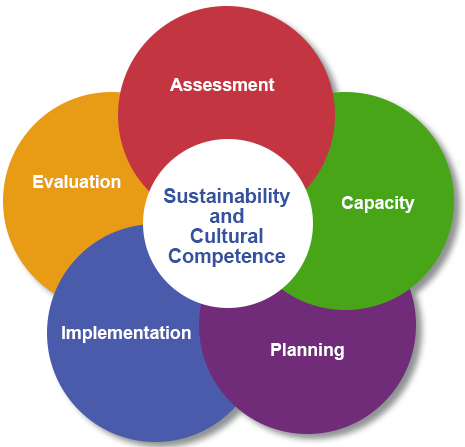Substance abuse prevention is actively working prior to the onset of a disorder to prevent substance use or abuse. Prevention is an important part of the behavioral health continuum of care model, a comprehensive approach to behavioral health that recognizes multiple opportunities for addressing behavioral health problems and disorders. Each component presents opportunities for addressing behavioral health problems and for collaborating across sectors. Based on the Mental Health Intervention Spectrum, first introduced in a 1994 Institute of Medicine report, the model includes the following components:
The Substance Abuse Prevention Program works in both the Promotion and Prevention realms.
Research over the past two decades has tried to determine how substance use begins and how it progresses. Many factors can add to a person’s risk for substance abuse. Risk factors can increase a person’s chances for substance abuse, while protective factors can reduce the risk (NIDA, 2013). People have biological and psychological characteristics that can make them vulnerable or resilient to substance abuse problems. These characteristics are classified either as a protective factor or a risk factor (SAMHSA, 2015).
Through the Wyoming Prevention Needs Assessment (PNA), the Wyoming Department of Health measures a wide variety of attitudes, beliefs, and perceptions that have been shown to be related to alcohol, tobacco, and drug use along with violent and problem behaviors.
The Strategic Prevention Framework (SPF) is a planning process for preventing substance use and misuse developed by SAMHSA. The SAPP uses SPF model to fund evidence-based prevention activities on both a statewide and community level.
All funded communities implement the SPF public health model in their prevention efforts. The model assists community coalitions in engaging in data-driven strategic planning. This comprehensive and integrated approach is achieved through partnerships with law enforcement, community resource centers, and other valuable stakeholders.
The five steps and two guiding principles of the SPF offer a comprehensive process for addressing the substance misuse and related behavioral health problems facing communities.
Step 1: Assess Needs – Identify pressing substance use and related problems and their contributing factors, and assess community resources and readiness to address these factors, and assess community resources and readiness to address these factors.
Step 2: Build Capacity – Identify resources and build readiness to address substance use and misuse.
Step 3: Plan – Form a plan for addressing priority problems and achieving prevention goals.
Step 4: Implement – Deliver evidence-based interventions.
Step 5: Evaluate – Quantify the challenges and successes of implementing a prevention program.
The framework is guided by the following principles:
Cultural Competence – The ability to interact effectively with people of different cultures to ensure the needs of all community members are addressed.
Sustainability – Sustain prevention outcomes by building stakeholder support for your program, showing and sharing results, and obtaining steady funding.
